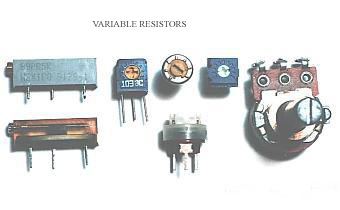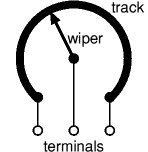Variable Resistors – Working and Applications
This article clearly defines and explains the working of variable resistors, the variable resistance specification, types, and applications.
Variable resistors find its application in most of the electronic circuits used today. We have been getting a lot of comments with questions on how a variable resistor works and so on. Here are the details.
TAKE A LOOK : POTENTIOMETER AND RHEOSTAT – WORKING AND COMPARISON
TAKE A LOOK : WORKING OF RESISTORS
TAKE A LOOK : METAL OXIDE VARISTOR (MOV)

What is a Variable Resistor?
A variable resistor is a device that is used to change the resistance according to our needs in an electronic circuit. It can be used as a three-terminal as well as a two terminal device. Mostly they are used as a three terminal device. Variable resistors are mostly used for device calibration.
Working of Variable Resistor
As shown in the diagram below, a variable resistor consists of a track which provides the resistance path. Two terminals of the device are connected to both the ends of the track. The third terminal is connected to a wiper that decides the movement of the track. The motion of the wiper through the track helps in increasing and decreasing the resistance.

The track is usually made of a mixture of ceramic and metal or can be made of carbon as well. As a resistive material is needed, carbon film type variable resistors are mostly used. They find applications in radio receiver circuits, audio amplifier circuits and TV receivers. For applications of small resistances, the resistance track may just be a coil of wire. The track can be in both the rotary as well as straight versions. In a rotary track, some of them may include a switch. The switch will have an operating shaft which can be easily moved in the axial direction with one of its ends moving from the body of variable resistor switch.
The rotary track resistor with has two applications. One is to change the resistance. The switch mechanism is used for the electric contact and non-contact by on/off operation of the switch. There are switch mechanism variable resistors with an annular cross-section which are used for the control of equipments. Even more, components are added to this type of a variable resistor so as to make them compatible with complicated electronic circuits. A high-voltage variable resistor such as a focus pack is an example. This device is capable of producing a variable focus voltage as well as a screen voltage. It is also connected to a variable resistance circuit and also a fixed resistance circuit [bleeder resistor] to bring a change in the applied voltage. For this, both the fixed and variable resistor are connected in series.
A track made in a straight path is called a slider. As the position of a slider cannot be seen or confirmed according to the adjustment of resistance, a stopping mechanism is usually included to prevent the hazards caused due to over-rotation.
Variable Resistance Specification
Various parameters like size, type of track and also resistance is used to define a variable resistance. Usually, the spindle diameter of a variable resistor is 6mm.
If the variable resistor has a straight track it is defined in the component by the short form LIN representing a linear track. If it is a rotary track it is represented in short as LOG, as for a logarithmic track.
A common representation is given below.
5K6 LIN – 5.6 kilo ohm with a linear track.
2M LOG – 2 Mega ohm with a logarithmic track.
In a linear track variable resistor, as the wiper is moved along the track the resistance varies constantly. In such resistors, the specification may not be given on the type. In that case, you will have to assume that it is linear.
In a logarithmic track variable resistor, the resistance does not increase/decrease constantly. As the wiper is moved from one end, the resistance changes at a slower rate and when the wiper is brought to the other end, the resistance changes at a fatser rate. This means that when the wiper is at halfway along the track, the resistance is not half the value of the total resistance. This is specifically applied for volume control as the response of the human ear to sound is also logarithmic. That is, a slow change in the beginning and a rapid change towards the end.
Application of Variable Resistors
There are mainly three types of variable resistors. They are
- Potentiometer
- Rheostat
- Presets
Potentiometer
A potentiometer is a 3-terminal variable resistor and is one of the most used in this category. It has two terminals and a wiper and works exactly like a variable resistor.
A potentiometer can be linear or logarithmic. For a linear potentiometer, its resistive track has the same cross-section from start to end whereas for a logarithmic one it is tapered to cause a logarithmic change in resistance.
Rheostat
Unlike a potentiometer a rheostat only has two terminals. Here one terminal is fixed while the other is a wiper which can be moved along a resistive surface. The resistance is varied depending on the distance between the fixed point and the wiper.
To know more about potentiometers and rheostat click on the link below.
TAKE A LOOK : POTENTIOMETER AND RHEOSTAT – WORKING AND COMPARISON
Presets
Presets are just smaller versions of a variable resistor. They can be easily placed on a PCB and can be adjustable when needed. The value of resistance is commonly adjusted with the help of a screw-driver. They are mostly used in applications like adjusting the frequency of an alarm tone or to adjust the sensitivity of circuits. Since this device is the cheapest among all the three they are more commonly used amongst all of them. There are also highly precise presets which have multi turn options. In this type, the resistance will increase/decrease only slowly and hence the screw has to be rotated many times. Here also the basic slider and track mechanism is used. The track mechanism is always linear. Take a look at the preset symbol.

Most of the variable resistors are placed directly on the PCB. Some are mounted by drilling a hole in the case containing the circuit and is connected to the terminals with the help of a wire.
In recent years, the size as well as the weight of such devices have been greatly reduced which makes it more suitable for any field of electronics.

18 Comments
My dear thanks so much.. God bless you
Its gives only a basic thing of variable resistors.more detailed specification is useful to clarify.
more clarification about types and characteristics of resistors
cooooooooooooooooooooooooooooool mersi de ajutor
good work… its da perfect answer 2 wat i wanted…..!!! thnxxx
what type of phtocell can be used for laser alarm
just inquiring about logic gates.thanxs